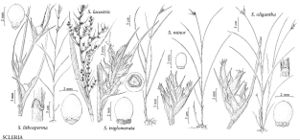Difference between revisions of "Scleria oligantha"
Fl. Bor.-Amer. 2: 167. 1803.
FNA>Volume Importer |
FNA>Volume Importer |
(No difference)
| |
Revision as of 21:08, 16 December 2019
Plants perennial; rhizomes elongate, nodulose, to 5 mm thick. Culms usually in tufts, erect, slender, 30–60(–70) cm, sometimes appearing weak, glabrous or hairy. Leaves: proximal sheaths purple tinged, the distal rosy red-tinged, usually narrowly winged, ribbed, pubescent or glabrous; contra-ligules ovate; blades linear, ribbed, shorter than or equaling culms, 2–6 mm wide, glabrous or ciliate to scabrous. Inflorescences axillary and terminal, of 2–5 small clusters, 5–20 × 5–10 mm, each with 1–4 spikelets; the lateral on reddish filiform peduncles dilated toward apex, hairy or scabrous on angles; bracts subtending inflorescence leaflike, linear-lanceolate, 3–10 cm, glabrous or ciliate. Spikelets bisexual and staminate, staminate part frequently reduced in bisexual spikelets, purple tinged, 3–8 mm; staminate scales lanceolate; pistillate scales ovate, acuminate. Achenes white or grayish or grayish brown with dark longitudinal bands, ovoid, shorter than scales, 3–4 mm, smooth, shining, apex umbonate; hypogynium golden brown, rather broad, base obtuse-trigonous, supporting 8–9 small, round or elongate, granulose-spiculose tubercles.
Phenology: Fruiting spring–summer.
Habitat: Mixed mesic to xeric woods or glades, wet meadows
Elevation: 0–500 m
Distribution
Ala., Ark., D.C., Fla., Ga., Ill., Ind., Ky., La., Miss., Mo., N.C., Ohio, Okla., S.C., Tenn., Tex., Va., Mexico, Central America (Guatemala, Honduras)
Discussion
Scleria oligantha sometimes extends from its typical wooded habitat to open areas.
Selected References
None.
